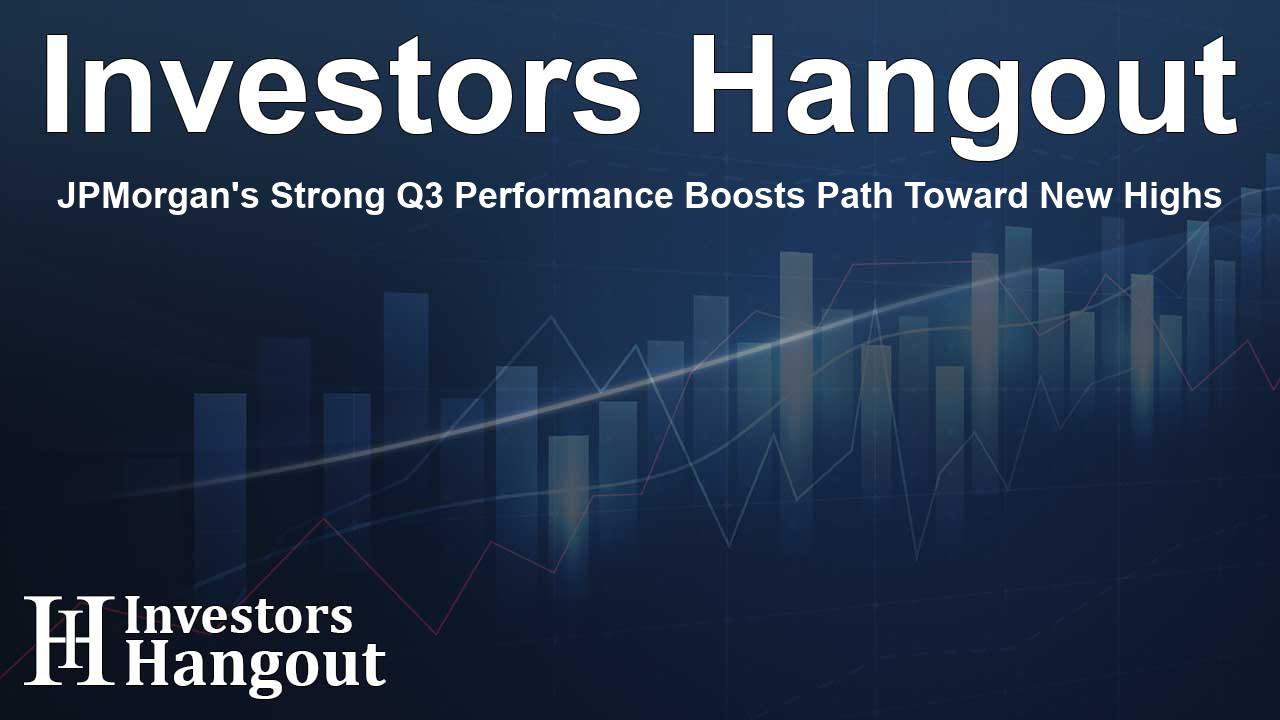JPMorgan's Strong Q3 Performance Boosts Path Toward New Highs

JPMorgan Chase Shows Promising Trends for Future Growth
JPMorgan Chase recently reported a stronger-than-anticipated quarter, indicating that the stock is poised to continue its upward trajectory and possibly achieve new record highs. Despite some concerns regarding credit reserve build-ups, overall earnings power has remained resilient, leaving the capital return outlook intact.
Analysts have been increasingly optimistic about the stock's potential to reach new heights this year, as their predictions reflect a confident outlook for JPMorgan Chase (NYSE: JPM). The company has defied fears stemming from previous guidance warnings, and its Q3 results exceeded expectations, showcasing robust cash flow and sustainable capital returns.
Market observers believe that the sell-off in September presented a prime buying opportunity, with the potential for double-digit upside for JPMorgan's stock before the year concludes. If the bank continues its strong performance, further upward revisions by analysts can be anticipated, which will likely contribute to a sustained momentum in the stock's favor.
JPMorgan’s Business Performance and Revenue Trends
In reviewing JPMorgan’s Q3 2024 performance, while not all news is positive, the company's diversified business model helped mitigate weaknesses in the consumer segments. Even with the consumer and community banking division experiencing revenue declines, other sectors such as Asset & Wealth Management saw significant gains.
JPMorgan reported $43.32 billion in revenue, reflecting a 6% year-over-year increase. Specifically, the Asset & Wealth Management sector led the charge with a 9% increase, while Commercial Investment Banking (CIB) also performed admirably with an 8% revenue rise attributed to increased fees and organic growth. Notably, investment banking revenue surged by 29% within CIB.
Despite the mixed news regarding margins, overall net income company-wide rose compared to last year, surpassing analyst expectations with a GAAP EPS of $4.37, which exceeded consensus estimates by $0.36. While credit costs have risen, indicating potential market uncertainties, the bank remains in a strong financial position with Tier 1 credit ratios comfortably above target levels.
The revised guidance remains positive. Recent projections for net income have increased by $1.5 billion to $91.5 billion, more than sufficiently supporting the capital return perspective, and also hinting at diminished impacts from falling interest rates.
Analyst Sentiment and Projections for JPMorgan Stock
Analyst activity regarding JPMorgan has seen varied movements since the September guidance alerts. Though some price target reductions and downgrades were noted, they were countered by upward revisions as the overall sentiment remains that the stock will reach new highs.
The consensus for fair value has set a target at $212, with a notable increase across the board in predictions over the subsequent 30, 90, and 365 days. The high-end estimates are climbing to between $230 and $240, suggesting potential new all-time highs which are approximately 10% above the stock's mid-October trading positions.
Charting a Bullish Future for JPMorgan
The stock's price movements since early September reveal an initial sell-off followed by a recovery, demonstrating the support levels that are currently in play. This sequential bounce aligns with a trend-following strategy, indicating bullish potential amplified by favorable crossovers in key market indicators.
The MACD suggests that the market is entering the early stages of a bullish trend, while stochastic indicators are showcasing a strong crossover—a promising signal for traders. Should the stock continue on this trajectory, it may soon revisit its all-time highs, paving the way for a technical breakout that surpasses the upper limits of the current analyst targets.
Frequently Asked Questions
What are the recent earnings results for JPMorgan Chase?
JPMorgan Chase reported a better-than-expected quarterly performance, with overall revenue up 6% year-over-year, resulting in a GAAP EPS of $4.37.
How do analysts view JPMorgan's stock potential?
Analysts are increasingly bullish, viewing JPMorgan's stock as having a high probability of reaching new all-time highs, with price targets rising.
What factors are influencing JPMorgan's stock price?
The stock's price is influenced by strong performance in various banking sectors, positive revisions of analyst estimates, and overall market trends.
How are credit reserves affecting JPMorgan?
While credit reserve build-ups have raised some concerns, they have not negatively impacted overall earnings power or capital return outlook.
What guidance has JPMorgan provided for the future?
JPMorgan has raised its net income guidance for the future, citing a projected increase of $1.5 billion, supporting continued positive capital returns.
About Investors Hangout
Investors Hangout is a leading online stock forum for financial discussion and learning, offering a wide range of free tools and resources. It draws in traders of all levels, who exchange market knowledge, investigate trading tactics, and keep an eye on industry developments in real time. Featuring financial articles, stock message boards, quotes, charts, company profiles, and live news updates. Through cooperative learning and a wealth of informational resources, it helps users from novices creating their first portfolios to experts honing their techniques. Join Investors Hangout today: https://investorshangout.com/
Disclaimer: The content of this article is solely for general informational purposes only; it does not represent legal, financial, or investment advice. Investors Hangout does not offer financial advice; the author is not a licensed financial advisor. Consult a qualified advisor before making any financial or investment decisions based on this article. The author's interpretation of publicly available data shapes the opinions presented here; as a result, they should not be taken as advice to purchase, sell, or hold any securities mentioned or any other investments. The author does not guarantee the accuracy, completeness, or timeliness of any material, providing it "as is." Information and market conditions may change; past performance is not indicative of future outcomes. If any of the material offered here is inaccurate, please contact us for corrections.